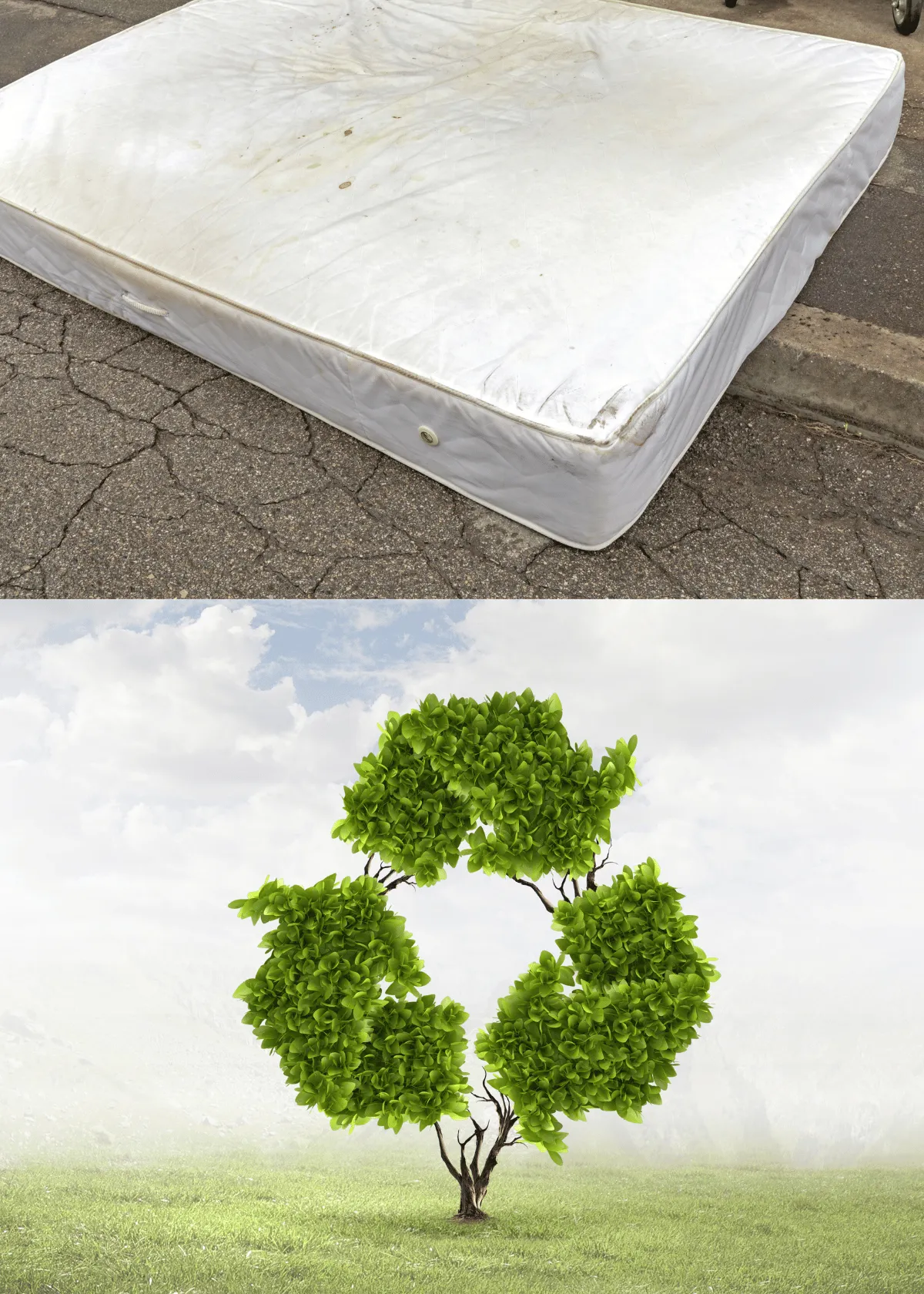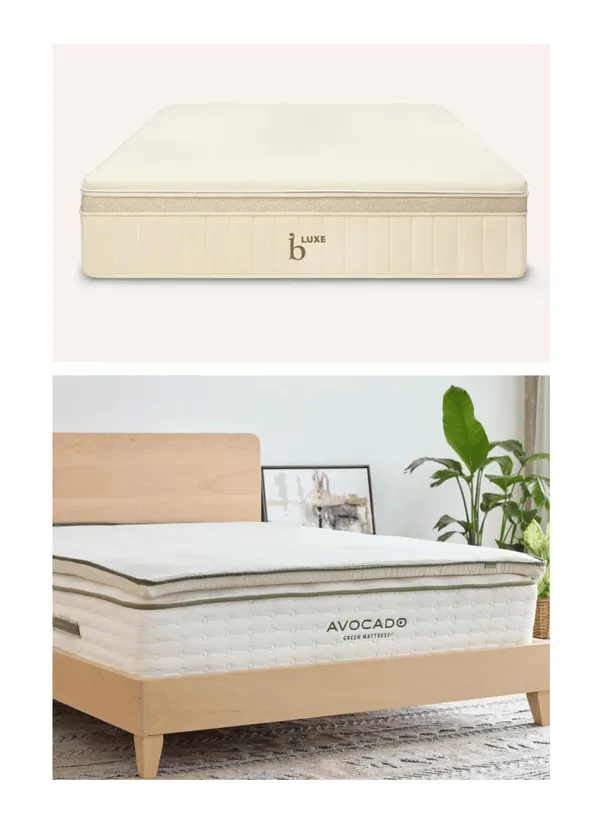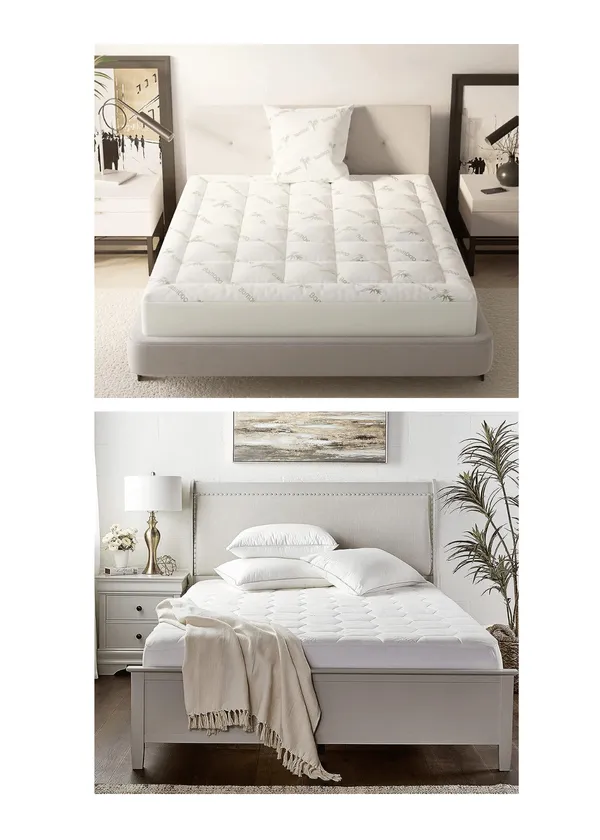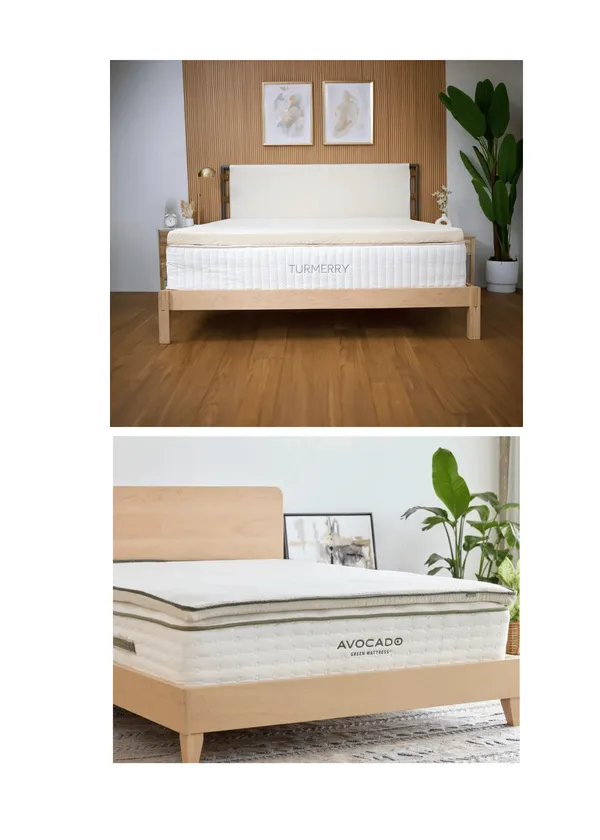(Last Update: 05/06/2024)
OUR TAKEAWAYS:
- Mattress recycling is important to reduce environmental hazards, conserve resources, and provide jobs.
- Creative DIY home projects or artistic endeavors can be used to repurpose old mattresses for a more sustainable future.
- Consider material considerations, certifications & labels, and lifespan/maintenance when buying a new mattress for an informed choice.
TABLE OF CONTENT
The Importance of Mattress Recycling
Creative Ways to Repurpose Your Old Mattress
Eco-Friendly Disposal Options
Tips for Buying a Sustainable New Mattress
Frequently Asked Questions
Did you know that your old mattress can significantly contribute to a greener planet? Instead of sending it to a landfill, where it can cause pollution and waste valuable resources, consider a more eco-friendly approach.
This blog post will explore the importance of finding creative ways to repurpose your old mattress and tips for buying a sustainable replacement mattress.

A Landfill With Various Junk Items
(Credit: Canva)
The Importance of Mattress Recycling
Recycling mattresses is essential for minimizing the environmental consequences of disposing of outdated mattresses, which can be a major source of pollution. The advantages of mattress recycling programs include minimizing waste, conserving resources, and generating local employment.
Unfortunately, over 20 million mattresses end up in landfills yearly, taking valuable space and releasing toxic chemicals into the atmosphere. Participating in mattress recycling programs can help reduce this burden on our environment. Recycling mattresses is not just about environmental benefits; it also helps to conserve resources.
More than 75% of mattresses can be recycled, and many materials used in manufacturing mattresses, such as steel springs, wood frames, foam bottoms, polyurethane memory foam tops, and fabric, can be easily recycled or reused.
This means valuable materials that would otherwise be discarded can be repurposed for other uses.
Environmental Impact
Mattress recycling has a positive environmental impact, as it helps reduce the amount of waste sent to landfills. Landfills are not only a significant source of greenhouse gas emissions, but they also contribute to soil and water pollution.
As more and more people become aware of how important it is to recycle mattresses, the number of old mattresses ending up in landfills can be significantly reduced.
The recycling process involves breaking down the bed into recyclable components, such as steel springs, wood frames, polyurethane foam, and fabric. You can recycle these materials for various uses, such as scrap metal, mulch, carpet padding, and insulation.
These recyclable materials help reduce debris, conserve resources, and contribute to a circular economy that promotes sustainability and reduces our environmental footprint.
Benefits of Recycling
- One primary benefit of recycled mattresses is reducing waste sent to landfills.
- By recycling old mattresses, we can minimize the environmental impact of landfill sites, which emit harmful greenhouse gases, contaminate soil and water sources, and occupy vast amounts of space.
- Recycling used mattresses also helps to recycle and conserve valuable resources, such as steel and box springs, wood frames, polyurethane memory foam, and fabric, which can be repurposed for other uses.
- Another significant benefit of the mattress recycling programs is the creation of local job opportunities.
- As the demand for recycling services increases, so does the need for individuals to collect, sort, and process the recycled materials from old mattresses into valuable materials.

Piles of Mattresses on the Street
(Credit: Canva)
Creative Ways to Repurpose Old Mattress
- If you need more time to be ready to part with your old bed, several creative ways exist to recycle it and give it a new lease on life.
- From DIY home projects to artistic endeavors and community initiatives, there are countless possibilities for transforming your old mattress into something useful and unique.
- By repurposing your old mattress with bed bugs, you not only reduce debris and contribute to a more sustainable future, but you also have the opportunity to explore your creativity and engage with your local community.
DIY Home Projects
- One creative way to reuse, recycle, or repurpose an old mattress is to use it for various DIY home projects.
- For instance, you could transform metal springs or box springs from the mattress into a comfortable pet bed or create outdoor seating for your patio or garden.
- The metal springs from the recycled mattress can also be used to create unique recycled items, such as wreaths, photo holders, or holiday decor.
- Most mattresses, despite their seemingly singular purpose, are treasure troves of valuable, highly recyclable materials.
- You can recycle these components, including metal springs, memory foam, box springs, wood frames, and steel coils, thus preventing their disposal in a landfill.
- In addition, many mattresses can be cleverly converted into snack holders or other useful items, showcasing how recycling and creative repurposing can lead to a greener planet.
- By understanding the recyclable potential of each part of a mattress, we can reduce debris and make the most of the recycled materials available.
- Inflatable foam, mattress springs, and foam scraps can be utilized for various purposes, such as liners for plant pots or outdoor grill covers.
- With a little imagination and some elbow grease, you can turn your older bedding, box spring, and foam part into a functional and stylish addition to your home.
Artistic Endeavors
If you have a flair for creativity, an older mattress can serve as an excellent canvas for an art project. You can use various painting techniques, stitching, fabric, or other decorative methods to create unique artwork that showcases your artistic talents.
You can recycle the stuffing from an old mattress into pillows, cushions, or other soft furnishings. You could even use the wood frame or scrap metal frame from the bed as a base for a padded bench at the foot of your bed. The possibilities are endless, and the result will be a unique addition to your home and a testament to your commitment to sustainability.
Community Initiatives
Another creative way to recycle, reuse, or donate an older mattress is to engage in community initiatives. For example, organizing a bed donation drive for a local charity or homeless shelter is a great way to make a difference in your community and support those in need.
Many individuals are adopting sustainable practices like mattress recycling, thanks to resources provided by organizations like the Mattress Recycling Council.
Increasingly, more mattresses are being diverted from landfills and given new life through recycling. Several options are available for those looking to get rid of their old mattresses. Thrift stores and the Red Cross are popular choices as they accept mattresses for reuse. Another emerging platform is the Facebook Marketplace, which allows people to donate or recycle mattresses.
Many mattresses are constructed with flame retardants, which can be processed safely when recycled, keeping harmful substances out of landfills.
You could also collaborate with local artists, schools, or community centers to create a public art installation or playground equipment using repurposed mattresses. Again, this would help promote sustainability and recycling and foster a sense of community pride and involvement.

Piles of Mattresses to Be recycled
(Credit: Canva)
Eco-Friendly Disposal Options
If you've decided it's time to part with your old mattress, consider eco-friendly options to minimize its environmental impact.
Some options include manufacturer take-back programs, centers to donate it, landfills, and local recycling centers.
An eco-friendly mattress minimizes environmental impact, using sustainable, biodegradable materials and production methods that reduce waste and harmful emissions.
Before you dispose of old mattresses, research the various mattress recycling council programs and organizations in your area.
Manufacturer Take-Back Programs
Some mattress manufacturers have take-back or recycle programs in place to recycle mattresses. These programs ensure that the fabric and various components of your old mattress are recycled or repurposed in a biodegradable manner.
When you purchase a new bed, please ask about the manufacturer's take-back or recycle program and any associated disposal fee.
Instead of hauling your old mattress to a recycling facility or a center where to donate it, the manufacturer will typically arrange for it to be picked up when your new mattress is delivered. This makes the entire process more convenient and hassle-free for you.
Donation Centers
Donating your old bed to a donation center is among the eco-friendly options. In addition, organizations like the Salvation Army, Habitat for Humanity, and Goodwill accept mattress donations and redistribute them to those in need.
By donating your old mattress and recycling it here, you help reduce debris and support local homeless shelters for those who cannot afford a proper sleeping surface.
Before you donate your mattress, could you research the specific requirements and regulations for mattress donations in your area?
Some organizations may have strict guidelines regarding the condition and cleanliness of donated mattresses, so it's essential to ensure that your mattress meets these criteria before donating.

A Mattress in the Snow
(Credit: Canva)
Mattress Recycling Program at Local Recycling centers
- A Local mattress manufacturer, mattress recycling council, and facility are other options for biodegradable mattress disposal.
- Mattress recycling services are provided by programs like the Mattress Recycling Council's Bye Bye Mattress, NW Furniture Bank's Mattress Recycling Center, and King County's LinkUp program.
- Rhode Island also participates in the Bye Mattress, a voluntary recycling program. The program allows residents and businesses to drop off used mattresses or box springs at designated collection sites for recycling.
- Recycling your old mattress at a local facility ensures that the various components are being repurposed in an environmentally responsible manner.
- Recycling a mattress offers a biodegradable solution to debris, utilizing materials like polyurethane foam, a wood frame, and steel coils.
- Polyurethane foam can be repurposed for padding; wood frames can become mulch, and steel coils are new metal products.
It's important to research the specific requirements and fees associated with bedding recycling programs in your area, as these may vary depending on the facility and the raw materials you use in your bedding.

A Mattress Recycling Process
(Credit: Canva)
Tips for Buying a Sustainable New Mattress
- When purchasing a new mattress, several factors must be considered to ensure you make an eco-friendly and sustainable choice.
- These factors include material considerations, certifications and labels, and lifespan and maintenance.
- By carefully evaluating these aspects, you can make an informed decision and invest in a mattress that provides a great night's sleep and contributes to a greener planet.
In the following sections, we'll explore these factors further and provide helpful tips for selecting a sustainable mattress that meets your needs while minimizing environmental change.
Material Considerations
- When purchasing sustainable bedding, it's essential to consider the materials used in its construction.
- Look for natural and organic mattresses and consumer products such as organic cotton, natural latex, Tencel, and wool.
- These materials are biodegradable, non-toxic, and sourced from renewable resources that grow quickly and abundantly.
- Avoid synthetic materials: These materials in mattresses can release harmful chemicals, cause allergies, and are less sustainable than natural alternatives.
- In addition to being better for the environment, mattresses made from these recycled materials are often more breathable and hypoallergenic, making them an excellent choice for individuals with allergies or sensitive skin.
By choosing a sustainable mattress, you can rest assured that you're getting a comfortable and healthy night's sleep and contributing to a more sustainable future.
Certifications and Labels
- Certifications and labels are essential when purchasing a sustainable mattress, as they guarantee that the product meets specific standards and is safe, sustainable, and high-quality.
- When selecting a mattress, look for certifications such as Greenguard, Oeko-Tex, Global Organic Textile Standard (GOTS), and Made Safe.
- These certifications indicate that the mattress has been tested for specific chemical emission limits and that the average mattress is free of harmful toxins.
By choosing a few mattress manufacturers with these certifications, you can ensure that you're investing in a product that is not only biodegradable but also safe and healthy for you and your family.
Lifespan and Maintenance
The lifespan and maintenance of a sustainable mattress are important factors to consider when purchasing. A mattress that lasts longer and requires less upkeep is more cost-effective and helps reduce debris and the need for frequent replacements.
To extend the lifespan of your sustainable mattress, maintain clean sheets, use an organic mattress pad, regularly flip and turn the foam mattress, and sun-dry it when possible.
Following these maintenance tips ensures your mattress stays fresh and comfortable for years while contributing to a more sustainable future.

The Recycling Logo
(Credit: Canva)
SUMMARY:
In conclusion, mattress recycling is a crucial step towards a greener planet, and there are numerous ways to repurpose your old mattress or dispose of it responsibly.
In addition, by considering materials, certifications, and lifespan when purchasing a new mattress, you can make a biodegradable choice that benefits your health and the environment.
So, let's work together to recycle used mattresses and create a more sustainable future, one good night's sleep at a time.
Frequently Asked Questions
- How can I reuse an old mattress?
Reusing an old bedding or mattress is easy and can be done creatively. Options for reuse include making comfortable pet beds, stuffing for pillows, padded benches, mattresses with insulation or soundproofing, or sleep mats for your children.
With these ideas, you can give the space under your old mattress a new life!
- Can you compost a mattress?
No, it is not recommended to recycle or compost a mattress. Mattresses contain many chemicals and materials which can contaminate the compost and make it unsuitable for gardening.
Instead, consider donating or recycling the top layer of your bedding as a better option for disposing of it.
- How long does it take for a mattress to decompose?
It can take up to 120 years for a mattress to decompose, making it an unsustainable solution when disposing of your old mattress. To help reduce environmental change, consider eco-friendly disposal options before taking your mattress to the dump.







